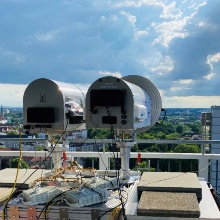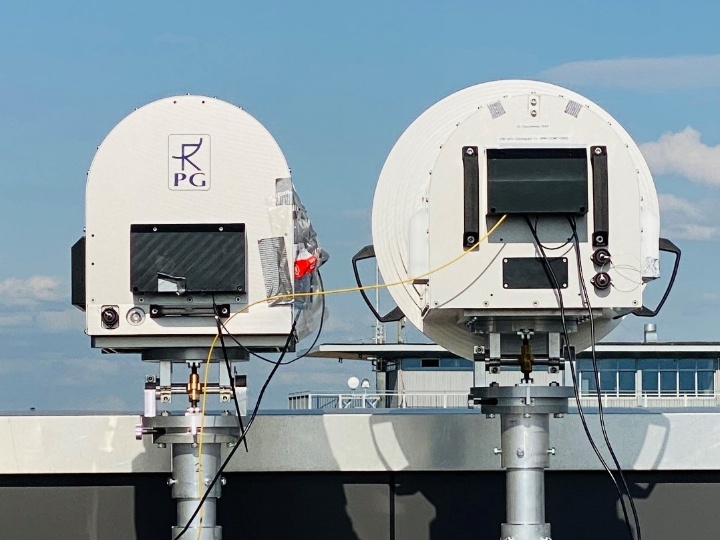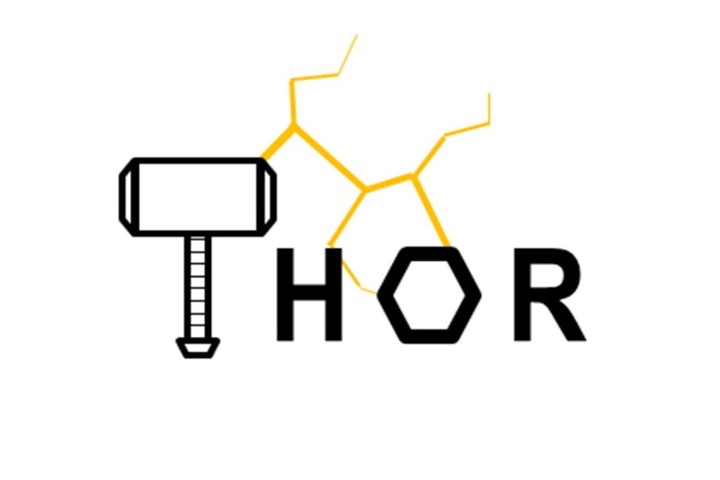As part of the "ThoR" project, scientists at the University of Stuttgart have succeeded in demonstrating the world's first bidirectional terahertz (THz) point-to-point link with an Internet connection. This is intended to serve as a backhaul link for future mobile radio applications. The Institute for Robust Power Semiconductor Systems (ILH) is part of a consortium of twelve partners from five countries. The project is led by TU Braunschweig and Waseda University (Japan). At the end of June, the THz radio link was presented at a final workshop.
The option of implementing high-bit-rate data transmissions via fiber optic cable is not always available everywhere. In densely built-up cities, in remote locations, where there are natural obstacles, in disaster situations or at mass events, it is often not possible to connect every base station of the mobile network by cable and provide enough bandwidth. Here, terahertz directional radio links are an attractive alternative. They can bridge distances of up to one kilometer. This creates important backhaul connections between mobile communications cells and the nodes of the mobile communications network without having to carry out road construction measures.
Large data transfers possible without fiber optic cable
Until now, the high data rates produced by the 5G mobile communications standard, which are expected to increase even further in the future 6G standard, have argued in favor of a fiber-optic connection of the stations to the data network. The international ThoR project has now succeeded in developing a bidirectional terahertz radio link with a network connection that can transmit precisely these high data volumes. The frequency range above 300 gigahertz (GHz) is used for this purpose, as it offers enough spectrum for high data rates.
The ThoR backhaul link is the only link of its kind in the world to offer a true bidirectional data link and connects the "Informatikzentrum" and the "Okerhochhaus" of the TU Braunschweig over a distance of 160 meters. It can transmit net data rates of 2 times 20 Gbit/s at a bandwidth of 2 times 8.64 GHz. The developed THz radio link is scalable over the bandwidth so that higher data rates can also be realized. "We have realized a complete solution here that is close to the application and can already be used as a backhaul link in the data network in the near future," says Professor Thomas Kürner of TU Braunschweig, head of the European part of the project. In addition, as the first backhaul link of its kind, its functionality complies with the IEEE 802.15.3 standard. This standard was already developed in the run-up to the ThoR project with significant participation of the TU Braunschweig and some Japanese partners.
The research team from the University of Stuttgart developed the novel, broadband transmit and receive circuits for the ThoR project based on a high-performance transistor technology from the Fraunhofer Institute for Applied Solid State Physics IAF. Together with French project partners IEMN and Lille University, they realized the terahertz radio at 300 GHz. The radio enabled the world's first network connection of a terzhertz radio link by processing up to four gigabit modems in parallel.
Mobile network 6G: University of Stuttgart researches technological requirements
The ThoR project was funded by the EU through the Horizon 2020 research framework program and by the National Institute of Information and Communications Technology in Japan with a total of three million euros. The four-year project duration ended on June 30, 2022. At the University of Stuttgart, the research work is currently being continued as part of the Open6GHub project funded by the German Federal Ministry of Education and Research (BMBF). In addition to the Institute for Robust Power Semiconductor Systems (ILH), the Institute for Telecommunications (INÜ) is also conducting research on the technological requirements for the 6th generation mobile communications network.
ThoR-Project
ThoR is the acronym for "TeraHertz end-to-end wireless systems supporting ultra high data rate applications". Partners of the ThoR project are: Braunschweig University of Technology (EU coordinator, Germany), Waseda University (Japan coordinator, Japan), Chiba Institute of Technology (Japan), Gifu University (Japan), University of Stuttgart (Germany), Fraunhofer Institute for Applied Solid State Physics IAF (Germany), University of Lille-CNRS IEMN&PhLAM Laboratories (France), HRCP R&D Partnership (Japan), Vivid Components Ltd. (UK), Siklu Communication Ltd. (Israel), NEC Corporation (Japan) and Deutsche Telekom (Germany/Czech Republic).
Expert Contact:
Prof. Ingmar Kallfass, Institute for Robust Power Semiconductor Systems (ILH), University of Stuttgart, phone +49 711 685-68747, e-mail




